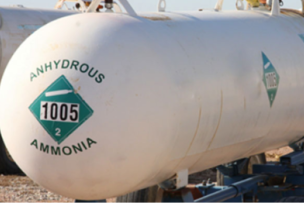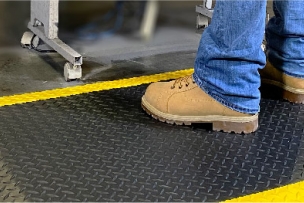Q: What’s the biggest concern that you see related to heat stress in manufacturing?
NELSON: People can be working indoors in extremely high heat, where they don’t have the ability to start the day early or end it later when the temperatures are lower, like workers who are outside. Workers could be exposed to high radiant heat that their body is absorbing every time they’re doing their job.
Anytime you have layers of personal protective equipment (PPE), whether that be flame-resistant clothing or an impermeable suit, it can not only trap heat in but also limit the types of cooling PPE that can be worn.
Q: Why is a standard necessary for heat stress in the workplace?
NELSON: For a long time, it was not really deemed necessary, until recently. NOAA—the National Oceanic and Atmospheric Administration—has published data claiming that temperature extremes are happening more frequently. Higher temperatures are leaving outdoor and indoor workers at a higher risk for developing heat-related illnesses. There is a desire and need to better understand what causes heat-related illnesses and how we can protect workers. People are getting more vocal about it, which I think is wonderful.
Read more: Heat Stress Prevention: Safety in Manufacturing and Industrial Environments
There were some recent studies that came out stating that anytime an outdoor or indoor temperature is 85 to 90 degrees, there is almost a 10 percent increase in chances of developing a heat-related illness, compared with 60-to-65-degree temperatures, and anytime ambient air temperatures are above 100 degrees, it can be a 15 to 20 percent increase in heat-related illnesses. So I think the data is pointing everyone in the direction of standardization, so we can make sure we’re protecting workers who are exposed.
Q: What is the standard for heat stress?
NELSON: The standard depends on where you live. Minnesota is the only state that has an indoor heat-stress standard that has been written and approved by federal OSHA. California and Washington state have standards specific to workers in an outdoor setting that have been approved by federal OSHA. Everyone else who works in other states falls under federal OSHA jurisdiction.
Currently, all recordables related to heat stress are bucketed under OSHA’s General Duty Clause. It’s an umbrella standard that states an employer must provide a workplace free from recognizable harms or hazards, and that includes heat-stress hazards.
Q: Is a more specific standard for heat stress in the works?
NELSON: California implemented their heat-stress standard nearly 10 years ago, and they’ve reduced the amount of heat-related injuries and fatalities by almost half. So we’re seeing the results of states implementing their own standards and how it’s been effective for them. There is an overall thinking that this would be something that should be pushed through at a federal level.
There are a few groups reviewing and proposing standards that will take close to what California has as their outdoor heat-stress standard and make that a federal standard. We’re really pushing to have an opportunity to make water, rest and shade not just part of an overall campaign and suggestion from OSHA, but a requirement for those who are on the job site.
Q: How is Ergodyne involved in establishing this standard?
NELSON: Ergodyne actively participates in the heat-stress working group through ISEA (International Safety Equipment Association). We and other manufacturers of PPE products related to cooling and hydration for heat stress get together and propose what we think could be a part of the standard, for PPE and also general guidance. We have the ability to send our comments directly to OSHA for review, and we have conversations with them as they’re working through the development of their standard. It’s a really good opportunity for us to share our product knowledge.
OSHA does an excellent job of understanding types of guidelines that can be implemented but not necessarily understanding how PPE can in turn impact the worker, and so being able to provide our guidance there is definitely helpful for everyone.
Q: What can manufacturers do to protect workers from heat stress?
NELSON: There are a lot of considerations that need to be taken. That could be more frequent breaks for water, more frequent recovery time, where they rest their body and slow their metabolic rate, rehydrating more frequently, and providing safe opportunities to remove PPE that they’re wearing to help cool their body down.
Additionally, on the PPE side, there are certain types of cooling products that you don’t have to worry about environmental variables. Phase change packs can be worn for a consistent amount of time under protective equipment that will help thermoregulate body temperature more easily.
Read more: How to Spot and Stop Heat Stress Symptoms
Q: Can you tell us about Ergodyne’s solutions to help workers avoid heat stress?
NELSON: When you’re trying to thermoregulate—when your body wants to cool itself more quickly—there are areas where you have large blood vessels located near the surface of the skin. When you’re in a high-heat setting, having something like a phase change vest or a phase change pack sit on the core of the body is going to be the most productive and efficient at getting your body where the temperature needs to be.
Phase change products are great for those in manufacturing, because once they’re activated, they are going to maintain a consistent temperature. Our packs sit at 64 degrees Fahrenheit for up to four hours. It’s significantly cooler than your body’s natural temperature, so it’s going to help bring it back when it starts to overheat without risking exposure to very cold temperatures that you’d get with an ice pack. You don’t want to put ice on your core.
Another nice thing is you don’t have to worry about humidity or air flow. You know you’re going to have a consistent temperature on your core for two to four hours.
What heat hazards do you have at your workplace, and how are you protecting your workers from them? Share with us in the comments below.




Talk to Us!
Leave a reply
Your email address will not be published. Required fields are marked *